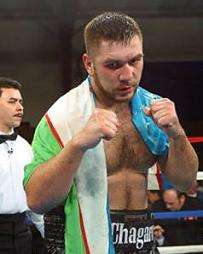Southpaw stance


In boxing, a southpaw stance is where the boxer has his right hand and right foot forward, leading with right jabs, and following with a left cross right hook. It is the normal stance for a left-handed boxer. The corresponding designation for a right-handed boxer is orthodox and is generally a mirror-image of the southpaw stance.
Strategy
Left-handed boxers are usually taught to fight in a southpaw stance, but right-handed fighters also fight in the southpaw stance. Fighting in a southpaw stance is believed to give the fighter a strategic advantage because of the tactical and cognitive difficulties of coping with a fighter who moves in a mirror-reverse of the norm. This is why left-handed fighters are brought up fighting in this orthodox stance. Another reason some left-handed fighters are brought up fighting in the orthodox stance is due to the (real or perceived) limited number of trainers who specialize in training the southpaw stance.
A skilled right-hander, such as Roy Jones Jr. or Marvin Hagler may switch to the left-handed (southpaw) stance to take advantage of the fact that most fighters lack experience against lefties. In addition, a right-hander in southpaw with a powerful left cross obtains an explosively different combination. The converted southpaw may use a right jab followed by a left cross, with the intention of making the opponent slip to the outside of his left side. Then the converted right-hander can simply turn his body left and face his opponent, placing him in orthodox, and follow up with an unexpected right cross. If the southpaw fighter is right-hand dominant with a strong left cross, this puts the opponent in danger of knockout from each punch in the combination, as jabs with the power hand can stun or knock out (KO) in heavier weight classes.
While rare, the reverse is also true for left-handers; left-hand dominant fighters like Oscar De La Hoya and Miguel Cotto who fight from an orthodox stance give up the so-called "southpaw advantage" strategically, but are gifted with heavier lead hands. Consequently, in MMA if one stands in a southpaw stance (strongside forward), one must train one's cross and left low kick to make it fast, hard and dangerous.
Previous uses of the term southpaw
Though many claim that the term originated due to the orientation of baseball playing fields in order to keep the sun out of the players' eyes and the resulting alignment of a left-handed pitcher's throwing arm,[1][2] the term had been used decades prior to that to indicate "not-usual".[3]
Southpaw fighters divided by sport
Boxing: Manny Pacquiao, Marvin Hagler, Hector Camacho, Pernell Whitaker, Joe Calzaghe, Vicente Saldivar, Tiger Flowers, Young Corbett III, Gabriel Elorde, Sergio Martínez, Ivan Calderon, Freddie Miller Victor Ortiz, Sultan Ibragimov, Naseem Hamed, Lucian Bute, Deontay Wilder
Muay Thai/Kickboxing/K-1: Mirko Filipovic, Saenchai, Giorgio Petrosyan, Raymond Daniels
MMA: Conor McGregor, Stephen Thompson, Luke Rockhold, Anthony Pettis, Darren Till, Nick Diaz, Nate Diaz, Anderson Silva, Holly Holm, Robbie Lawler, Matt Mitrione, Vitor Belfort, Benson Henderson
See also
References
- ↑ "I read somewhere that all major league baseball stadiums must point in the same direction (3rd base line north). Is this true?". Info Please.
- ↑ "Southpaw". Free Dictionary.
- ↑ Wilton, Dave (July 5, 2012), Southpaw, Word Origins
| Side | Left | Both | Right |
|---|---|---|---|
| General | Ambidexterity | ||
| In cognitive abilities | Geschwind–Galaburda hypothesis | ||
| In brain | |||
| In eyes | Ocular dominance | ||
| In hands | Left-handedness | Cross-dominance | Right-handedness |
| Handedness in boxing | Southpaw stance | Orthodox stance | |
| Handedness in people | Musicians | ||
| Handedness related to | |||
| Handedness measurement | Edinburgh Handedness Inventory | ||
| Handedness genetics | LRRTM1 | ||
| In heart | Levocardia | Dextrocardia | |
| In major viscera | Situs solitus | Situs ambiguus | Situs inversus |
| In feet | Footedness | ||
| Footedness in surfing | Regular foot | Goofy foot | |